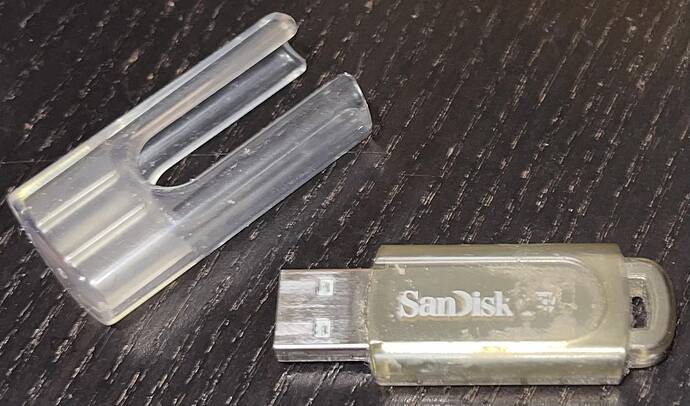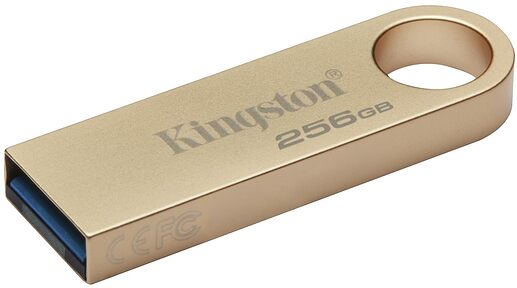I recently read in a tech blog that the writer was improving their emergency ‘go bag’.
While I don’t live in an area with high risk of wildfire or flooding, I thought about our situation and realized I could be better prepared, and maybe the early part of each year is the time to do it, as many records are changed then ie tax returns, property tax and so on.
One of the ideas is having a rugged, waterproof USB stick with digital versions of key documents. I searched online and a top rated usb drive has only a USB-A connector.
Just wondering if anyone here has researched this further and has pointers, product recommendations, keywords to share.
Or maybe that small SSDs like the Samsung T or Novus Helix series are already pretty rugged and thinking about a USB stick is just making extra work for myself when I could just normally have such a thing doing full Data Volume backups instead of just ‘essential’ documents.
Caveat: I’m not and won’t be a Cloud user, I prefer my data as local as possible, so I’m visualising something I could literally grab and stick in a rucksack or duffle with other stuff. Beats hauling a fireproof safe full of documents!
Or maybe that small SSDs like the Samsung T or Novus Helix series are already pretty rugged and thinking about a USB stick is just making extra work for myself when I could just normally have such a thing doing full Data Volume backups instead of just ‘essential’ documents.
SSD’s are the way to go for sure. They’re tiny, truly inexpensive for what you get, and you’re backing up all of your user data.
Dave
My two go-bags each hold a standard, major brand USB stick containing encrypted copies of my critical documents and macOS Keychains. I rewrite the data to the sticks once or twice a year or after major additions or updates to the stored information.
I already have redundant full backups of my Mac so my aim for my go-bags is to keep things simple and compact. One thing I might do now, after reading your post, is put the sticks into plastic bags. I don’t think I would go out of my way to buy hardened or mil-spec sticks, though.
Great question, looking forward to responses.
Since I have successfully used Quicken for many years ever since MacMoney died I tried Quicken’s LifeHub offering described as…
The smarter way to organize, protect, & share life’s essential information
LifeHub is built with Quicken’s 256-bit encryption & multi-factor authentication to help keep your info safe from fire, flood, corrupted files, hackers, and more.
It isn’t a mature product but I have found it at least adequate for a lazy man who doesn’t run from helpful subscription software and is willing to (more or less) trust 256-bit encryption. YMMV.
![]()
Ideally, when the need to evacuate arises, you can collect your go bag and take it with you. But what if you’re not at home and can’t safely return it or have someone else bring it to you? What do you do then?
That’s why it’s essential to store a version of your system off-site and a recent backup of your most active, essential data either with you or in the cloud, not in your go-bag.
I use two SSDs as part of my Time Machine strategy. One stays in the car. The other is in my go-bag. On a roughly weekly basis I plug them into the Mac. Time Machine then updates them automatically and I return them to the car/bag.
The car pack also has 50Gb blu-ray disks with really critical data such as my Mail Steward backup of decades of emails.
Excellent point, thanks!
Initial thoughts bring me back to a USB stick in that case. I carry on my pants belt a modified leather key pouch with tiny things that get damaged in pockets with keys, like a photo gray card, small pen, pince-nez, small note paper. I could put a stick in there and it would be with me whenever I leave the house.
If I had a slightly larger belt pouch, like for old compact cameras, I could have all that plus the SSD. Hm…
I used to carry a USB stick on my person at all times, back when I was working from an office and often needed to transport files between there and home.
I found that all were pretty compatible, but the cheap ones would come in plastic cases that break over time, especially when you’re carrying it in a pocket all the time.
I’ve found two that have been very durable. They’re no longer made, but perhaps you can find similar ones.
One, my favorite, is actually the oldest one I own. A 512 MB SanDisk Cruzer:
This has the drive sealed within a rubber-like enclosure and has a slip-cover for additional protection. Virtually indestructible. Sadly, it is very small and later model Cruzer drives have a much cheaper plastic enclosure that cracks under stress.
The other I like, which is still available, is the Kingston DataTraveler DTSE9. These have a solid metal enclosure that seems to hold up very well when carried in a pocket for years. I’d easily recommend buying a current version of one of these.
Of course, these are not SSDs, so they won’t be particularly fast, but they should work fine if you just need to transport a few critical files from place to place.
I’m closer to identifying the files and USB stick I will employ for this task.
An additional complication is password protection/encryption for multiple OSes.
For example if I always carry the stick for the case of not being able to return home for a go-bag, the stick should be capable of being used in USB-A & C hardware, on Mac and Windows.
I could use an encrypted .dmg but to open on a Windows machine that requires extra software as far as I’ve found.
One option is to employ a .dmg and add a step to convert it to a .iso. Or is there really an encrypted/password protected format that works on both OSes?
Something to consider is OWC’s Envoy Pro Elektron. I bought one during black friday last year, and it definitely seems to live up to their marketing hype. I haven’t tested it to destruction or anything, but it seems very solid. They claim IP67, which means it’s dust tight and protects against liquid immersion of up to 1m (3ft 3in) for at least 30 minutes. They also advertise it as crush proof (which I’m guessing involves driving an auto over it, not intentionally crushing it).
I’ve been happy with the purchase, and I’m planning to keep an eye out for another deal next November to get a 2nd one (perhaps larger).
Strong agreement that OWC Envoy Pro Elektron rocks!
Seems rugged and build quality is nice.
For cross-platform encryption, the easiest approach probably is to put the files you want to encrypt into a folder, and then save the folder as a password-protected encrypted zip archive.
The last time I looked into it, 7-Zip on Windows and Keka on macOS (both free) could create mutually compatible encrypted zip archives, but you would want to verify that on your own systems.
I also recall that some USB stick manufacturers would bundle (or at least let you download) file encryption apps for Windows and macOS with their USB devices. It has been awhile, but I think SanDisk has something called PrivateAccess or SecureAccess that does that. Note that such software generally only works on devices from the associated manufacturer, i.e., you can’t use the SanDisk software with a Samsung drive.
There also are commercial encryption tools that might give more flexibility.
Standard .zip encryption (“Zipcrypto”) is weak and not to be trusted for any high-value data. Most, but by no means all, zip utilities now support AES encryption but it isn’t standard, so you’d risk not being able to decrypt on your target machine if you don’t know, in advance, that it has a compatible decryptor.
GnuPG is cross-platform, though I doubt it’s found by default on most Windows machines.
I think I would probably put a symmetrically-encrypted .gpg file on your stick, along with GPG binary releases (see what I did there, Adam?) for various systems you thing might be targets when you decrypt: Windows, macOS, and Debian (Linux) at a minimum.
Right. I should have mentioned that one of the reasons I suggested 7-Zip and Keka (besides being free) is that they both support 256 bit AES encryption.
One option is to use Cryptomator, or a similar tool. Although they say “Cloud Storage Encryption”, you can create an encrypted vault on any valid storage device.
Another bonus is that you can use it with Cyberduck and MountainDuck to access encrypted vaults on server and cloud based storage.
Once again I want to remind everyone of the recent catastrophic SanDisk SSD failures since Western Digital purchased them. I posted about SanDisk’s Extreme SSD issues a while back.
While this may not apply to every single product SanDisk makes, and perhaps their recent separation from WD’s HDD division (see story below) might improve things over time, I would still urge caution with new purchases.
See the PetaPixel story below for context. Be aware that there are many who are displeased with WD’s management of SanDisk and refuse to use their product. Note the final paragraph from the story linked below:
SanDisk’s reputation among photographers and filmmakers has soured in recent years due in large part to its refusal to respond or take ownership of widespread failure of its portable SSD products. These SanDisk SSDs carried a major design flaw that caused them to suddenly and without warning stop working. SanDisk never publicly addressed the fiasco and, despite the known issue, continued to sell these SSDs at a discount to unsuspecting buyers. As a result, PetaPixel does not recommend photographers purchase any SanDisk products.
My 1 TB USB SSD stick just failed due to overheating. It was just over a year old. SanDisk is making it VERY HARD to get a replacement under warranty. Soooooo, who should I buy my next USB SSD stick from?
not as of Friday night! Their chat page is still a WD page.
While I am not up to speed on the current favorite USB stick brands, I have found Samsung and Crucial have good track record on ratings and durability.
Note: I am not a fan of the 1-piece metal keychain models. By this I mean the ones that look like a straight, single “bar” with an open revealing the USB-A plug, and a hook or loop on the opposite end. The entire electronic circuit board slides inside the metal shell and has to be glued to stay in place. Occasionally they can work themselves loose and fall out. This is really only a problem if you travel with it as the circuit board could fall out when you are not at home/office to see it.
Examples:
And, FWIW, my opinion is exactly opposite.
Back when I commuted to an office every day, I would keep a thumb drive in my pocket at all times, in order to bring files to/from the office.
I used several different models with plastic enclosures, and they all ended up cracked and broken after a few months in my pocket. These all-metal units held up perfectly and worked well for many years. I never experienced the board coming out of the enclosure.


